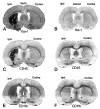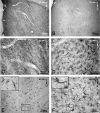Gemst: a taylor-made combination that reverts neuroanatomical changes in stroke
- PMID: 28735520
- PMCID: PMC5452634
- DOI: 10.4081/ejh.2017.2790
Gemst: a taylor-made combination that reverts neuroanatomical changes in stroke
Abstract
In a single transient middle cerebral artery occlusion model of stroke and using immunohistochemical techniques, the effects of a new therapeutic approach named Gemst (a member of the Poly-L-Lysine innovative therapies) have been studied in the rat brain. The expression of inflammatory (CD45, CD11b), oxidative (NO-tryptophan, NO2-tyrosine) and indoleamine 2, 3-dioxygenase pathway (kynurenic acid, 3-hydroxy anthranilic acid) markers has been evaluated in early and late phases of stroke. For this purpose, we have developed eight highly specific monoclonal antibodies directed against some of these markers. In the early phase (3 and 5 days of the stroke, we observed no effect of Gemst treatment (7.5 mg/day, subcutaneously for 3, 5 days). In the late phase (21 days) of stroke and exclusively in the ipsilateral side of non-treated animals an overexpression of kynurenic acid, 3-hydroxy anthranilic acid, CD45, CD11b, GFAP and ionized calcium-binding adapter molecule 1 (IBA-1) was found. In treated animals, the overexpression of the four former markers was completely abolished whereas the overexpression of the two latter ones was decreased down to normal levels. Gemst reversed the pathological conditions of stroke to normal situations. Gemst exerts a multifunctional action: down-regulates the indoleamine 2, 3-dioxygenase pathway and abolishes brain infiltration, microglial activation and gliosis. Moreover, Gemst has no effect on the expression of doublecortin, a protein involved in neuronal migration. Gemst could be a new drug for the treatment of stroke since it reverses the pathological findings of stroke and normalizes brain tissue conditions following the ischemic insult.
Conflict of interest statement
Conflict of interest: the authors declare no conflict of interest.
Figures







References
-
- Tatro B. Melanocortins defend their territory: multifaceted neuroprotection in cerebral ischemia. Endocrinology 2006;147:1122-5. - PubMed
-
- Olmez I, Ozyurt H. Reactive oxygen species and ischemic cerebrovascular disease. Neurochem Int 2012. 60: 208-12. - PubMed
-
- Ballinger SW. Mitochondrial dysfunction in cardiovascular disease. Free Radic Biol Med 2005;38:1278-95. - PubMed
-
- Beckman JS, Koppenol WH. Nitric oxide, superoxide, and peroxynitrite: the good, the bad, and ugly. Am J Physiol 1996; 271:C1424-37. - PubMed
MeSH terms
Substances
LinkOut - more resources
Full Text Sources
Other Literature Sources
Medical
Research Materials
Miscellaneous

